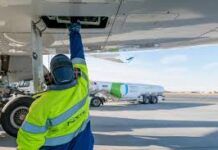 A system that gives cockpit warnings to pilots about bumpy air has been tested for the past month in some airliners flying east of the Rocky Mountains and feedback from pilots has been favourable. “The messages I’ve received in the cockpit gave a very accurate picture of turbulence location and intensity,” Captain Rocky Stone, chief technical pilot for United Air Lines, told editors at Weatherwise Magazine. “The detection of turbulence intensity provides an unprecedented and extremely valuable new tool for pilot situational awareness.” The system uses a formula developed by the National Center for Atmospheric Research (NCAR) and is called Nexrad Turbulence Detection Algorithm (NTDA). It works by analyzing wind distribution data gathered by radar sites and crunching the resulting numbers into predictions of where the ride will get rough.
A system that gives cockpit warnings to pilots about bumpy air has been tested for the past month in some airliners flying east of the Rocky Mountains and feedback from pilots has been favourable. “The messages I’ve received in the cockpit gave a very accurate picture of turbulence location and intensity,” Captain Rocky Stone, chief technical pilot for United Air Lines, told editors at Weatherwise Magazine. “The detection of turbulence intensity provides an unprecedented and extremely valuable new tool for pilot situational awareness.” The system uses a formula developed by the National Center for Atmospheric Research (NCAR) and is called Nexrad Turbulence Detection Algorithm (NTDA). It works by analyzing wind distribution data gathered by radar sites and crunching the resulting numbers into predictions of where the ride will get rough.
The information is then transmitted in real-time graphic form to pilots, airline meteorologists and dispatchers. The nature and cost of the gear required to receive the messages, which are sent out every 15 minutes, isn’t clear, nor is it known whether the turbulence maps will be available to general aviation aircraft. However, the plan is to have the system covering the full continental U.S. by 2011.

































